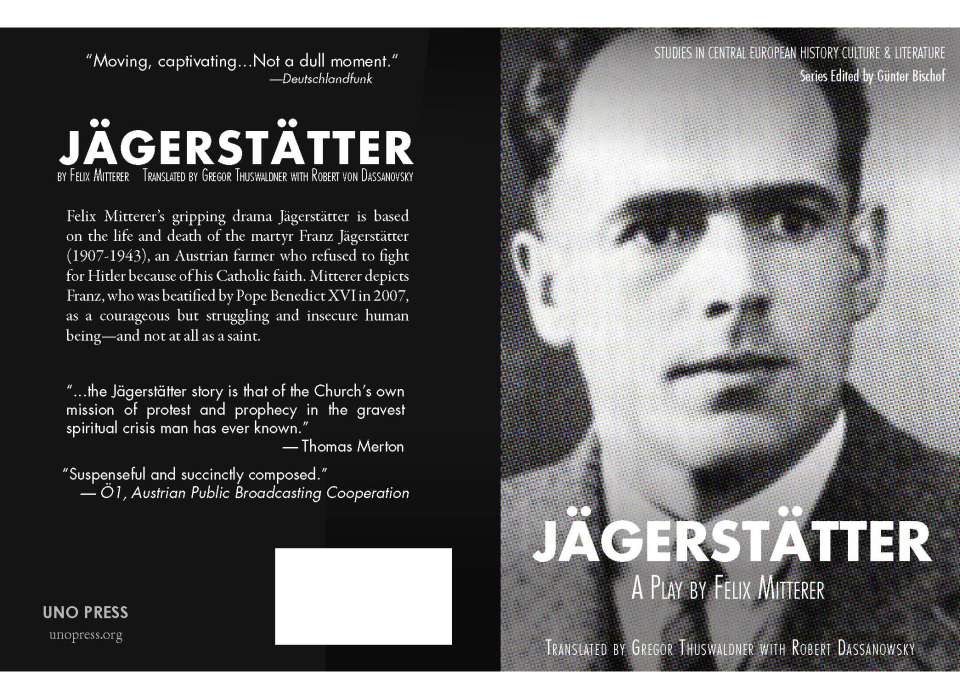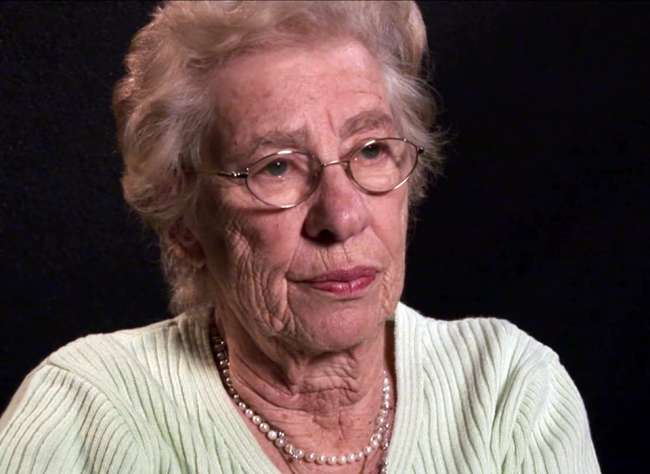Terrence Malick’s upcoming WWII drama is officially titled A Hidden Life. The long-in-the-making film was previously titled Radegund, the name of Franz Jägerstätter’s hometown in Austria. The historical drama stars August Diehl as Franz Jägerstätter, a conscientious WWII objector who was guillotined by the Third Reich in 1943. The supporting cast includes Valerie Pachner, Matthias Schoenaerts, and the late actors Michael Nyqvist and Bruno Ganz. Recent film industry buzz speculates that A Hidden Life may receive a world premiere at the Cannes Film Festival in May, bringing Malick back to the prestigious festival for the first time since winning the Palme d’Or with The Tree of Life.
Who was Franz Jägerstätter? On August 9, 1943, the Nazis executed the conscientious objector in a prison in Brandenburg an der Havel, close to Berlin. The simple Upper Austrian peasant from St. Radegund, situated in the Innviertel region close to Hitler’s birthplace of Braunau, was drafted into the Wehrmacht for military service in 1940. After weeks of basic training, he was exempted from military duty due to being “indispensable” on his farm. When he was drafted again in February 1943, Jägerstätter, the father of four young girls, refused to serve due to his strong religious convictions. The following is the summary of his own defense on July 6, 1943, from the trial records of the Reich Military Court in Berlin:
“Only in the past year had he become convinced that as a devout Catholic he was unable to engage in active military service. It was impossible for him to be a Catholic and at the same time a National Socialist. When he complied with the earlier conscription order, he did so because at that time he considered it a sin not to obey state orders. Now, however, God had given him the thought that it was not a sin to refuse armed service. There were matters in which one was obliged to obey God more than man; the commandment ‘Thou shalt love thy neighbor as thyself’ forbade him to engage in armed service, though he was prepared to serve as a paramedic.”
On November 1, 1943, only a few months after Jägerstätter’s execution, the Allied foreign ministers gathered in Moscow, and among many other decisions for the postwar world, also published a basic declaration on Austria. In it, the British, Americans, and Soviets agreed that Austria was “the first free country to fall victim to Hitlerite aggression” and therefore “shall be liberated from German domination.” They announced that the imposed “annexation” of Austria by Germany on March 15, 1938, was “null and void” and therefore they wished to “reestablish an independent Austria.” However, in a stern reminder, the three Allies told Austria that “she has a responsibility which she cannot evade for participation in the war on the side of Hitlerite Germany, and that in the final settlement account inevitably be taken of her own contribution to her liberation.” In other words, the “Moscow Declaration” was a general call for Austrian resistance against the Nazis.
Jägerstätter’s courageous refusal to serve in the German Wehrmacht was one of the most prominent acts of resistance by an ordinary Austrian during World War II. Not only that, Jägerstätter denounced Wehrmacht war crimes on the Eastern front—similar to the Scholl siblings in Munich also executed by the Nazis—long before anyone publicly dared to utter any critique of what became known as the Holocaust. Jägerstätter’s actions therefore contradicted false claims by Austrians who stated not having any knowledge about Nazi war crimes after the war. Yet, in a strange twist of irony, for a long period of time his courageous deeds of Nazi regime defiance were not prominently included in Austrian resistance movement(s) records against Hitler and the Nazis in postwar Austrian historiography. However, the reestablished Austrian government desperately searched for every scrap of paper to build a record of Austrian resistance against the Nazis in order to please the victorious Allies, who now occupied Austria. On April 27, 1945, the provisional Renner government incorporated the text of the Moscow Declaration of November 1, 1943, in its “Declaration of Independence” hook, line, and sinker. Thus was born the state doctrine of Austria as victim of the Nazi regime (the “victim myth”).
Soon after the rebirth the Austrian Republic, Foreign Ministry officials studiously began to collect the complete record of known Austrian resistance acts and published it in the Red-White-Red Book: Justice for Austria in 1946, just in time for the beginning of negotiations for an Austrian peace treaty (“state treaty”). Plans for a second volume on the Austrian resistance were scrapped due to a lack of further evidence. Strangely, Jägerstätter’s inspiring story was not incorporated in the Red-White-Red Book, possibly because the former Austrian Nazis began their slow comeback into state affairs and considered him a traitor rather than one of the most prominent Catholic resisters. Similarly, Jägerstätter’s wife, Franziska, who had encouraged him to follow his conscience during the war, experienced hostility and alienation from her neighbors and did not receive a war widow’s pension from the Austrian government, while hundreds of thousands of widows of Wehrmacht soldiers, who had died on the battlefields of Europe, did receive such pensions. In a strange twist, in postwar Austrian mainstream public opinion, soldiers who did “their duty” in the Wehrmacht (now also considered a murderous Nazi organization) were remembered as heroes, while resistance fighters were often criticized as “draft dodgers” and “traitors.”
If one follows the historiography on the Austrian resistance after the war, Jägerstätter’s defiance of the Nazi war machine was hardly mentioned. In 1958, Otto Molden, who had been in the “O5” resistance group in the final months of the war, stressed the record of Catholic conservative and monarchist resistance groups, along with the deeds of his daredevil brother, Fritz Molden, in “O5,” but ignored the Communist resistance. In a new book by Peter Pirker on the OSS “Operation Greenup” that occurred late in the war in the Tyrol, the Molden brothers resistance is minimized in comparison with the OSS agents’ heroics.
When the Documentation Centre of Austrian Resistance (situated on the left of the Austrian political spectrum) began its work in 1963, the Catholic Jägerstätter did not receive any special or prominent recognition. Instead, the broad resistance by Austrian communists, conservatives, monarchists, Catholics, and the military resistance were studiously recorded. At the same time, the Austrian government began financing a series of studies that concentrated on the Austrian resistance, however Jägerstätter was barely mentioned. Instead, it was the lone voice of American sociologist, Gordon Zahn, that brought world attention to Jägerstätter. Zahn stressed his record as a conscientious objector and heaved him out of obscurity, at least in the Anglo-American world. During the Vietnam War’s antiwar movement, conscientious objectors received considerable attention in the United States as brave souls, and Jägerstätter fit this model.
When Tulane University historian Radomír Luža published his history of the Austrian resistance in the 1980s, benefiting from the rich research of the Dokumentationsarchiv, he stressed the record of the Communist resistance, and Jägerstätter was ignored once again. It was only when the Catholic Church hierarchy in Austria took interest in the record of the Catholic resisters during World War II that Jägerstätter was rediscovered. This could have resulted from church leaders acting on their guilty conscience when they finally recognized the Catholic Church hierarchy’s craven submission to the Nazi regime during the war. On October 26, 2007, the Vatican, through the bishop of Linz, beatified Jägerstätter, the conscientious objector finally being bestowed with the halo of martyrdom from the Catholic Church. The bishop’s predecessor had tried to talk Jägerstätter out of sacrificing his life for his faith during World War II, and instead, align himself with the Nazis as the Catholic Church hierarchy had done. Jägerstätter started receiving the recognition he deserved as one of the most courageous Austrian resisters against the Nazi regime during World War II.
In the 1990s, the Austrian public began to take note of the record number of Austrian perpetrators during World War II (700,000 Austrians had been Nazi Party members and 1.2 million had served in the Wehrmacht). The Austrian government finally abandoned the “victim doctrine” and now admitted that Austrians bore “co-responsibility” for Hitlerite war crimes. As a consequence, the study of the Austrian resistance, which for so long had dominated WWII studies in Austria, fell by the wayside, and its record became understudied or ignored. However, Austrian “mastering of its past” and Jägerstätter’s beatification by the Vatican helped resistance studies to rebound. Wolfgang Neugebauer’s judicious study of the Austrian resistance finally gave Jägerstätter his due, placing him on the cover of the English version of Neugebauer’s publication as one of the most well-known Austrians to refuse submission to Nazi oppression. The 2005 symposium on the Austrian resistance, which was staged in the Austrian Parliament, was a government-sponsored event to further resurrect the record of the Austrian resistance as a central piece in the country’s WWII memory; Jägerstäter again was given his due.
Today, the lonely struggle that Jägerstätter fought against a murderous regime is now receiving attention in literature and film. The Austrian playwright Felix Mitterer’s thoughtful play—published in an English translation by Gregor Thuswaldner and Robert Dassanowsky for the first time by the University of New Orleans (UNO) Press in 2015—will add to Jägerstätter’s standing in the annals of conscientious objectors in the Austrian resistance. The play humanizes him by stressing his inner conflicts in arriving at the bold decision not to join the Wehrmacht, demonstrating how little time it took after the 1938 takeover of Austria (“Anschluss”) for the oppressive Nazi regime to nest itself into the deepest provinces of the renamed “Ostmark.” Mitterer does not hesitate to show the cravenness of the Catholic Church hierarchy, in addition to how the postwar community of St. Radegund remained hostile to Jägerstätter’s widow, Franziska, blaming her for Franz’s stubborn resistance to the Nazi regime and “senseless” death. Finally, Mitterer’s play raises troubling issues about the morality of wars today and the need for conscientious objection for religiously faithful people. As long as governments draft ordinary citizens to serve in the wars they unleash, such basic moral questions will remain vital. Malick’s film will further popularize Jägerstätter’s bravery and his self-sacrificing resistance.
About the Contributor:
Günter Bischof, PhD, is the Marshall Plan Chair of History and the Director of Center Austria at the University of New Orleans. He serves as a Presidential Counselor at The National WWII Museum, where he has also lectured in the past.
Cite this article:
MLA Citation:
APA Citation:
Chicago Style Citation:





![Max Fuchs, New York City cantor, sings as Rabbi Sydney [sic] Lefkowitz, Richmond, VA, conducts the first Jewish services from Germany.](/sites/default/files/styles/max_650x650/public/2025-10/image1.jpg)


